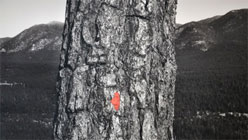The profusion of works and materials in Alice Shaw’s Landscape Update at Gallery 16 leaves viewers with the impression of a frenzy. The twenty-six works on view are made from an exhaustive array of media: paintings of oil and dye on linen; sculptures of cast bronze and concrete; photographs, including pigment, Van Dyke brown, and gelatin silver prints; and drawings or hybrid works of charcoal, ink, and gold leaf. Though the artist’s goal of exploring the landscape through various methods and materials is admirable, the effect is less comprehensive than it is schizophrenic. There are moments when Shaw’s depictions of a natural world sullied by human presence do shine, but overall the exhibition could have been improved by the notion that less is more.
Despite the show being weakened by the surfeit of approaches, there are many works that are intriguing and funny. Gum Print (2012) is a close-up, black-and-white photograph of a tree trunk that nearly blocks the view of the wild valley and pine-studded ridge beyond. The proximity of the trunk provides rich details of the rugged bark, showing bits of moss and an old bent nail stuck amongst its crevices; the image is so crisply captured that a viewer can almost feel the rough textures. However, the print is contaminated by a wad of actual chewing gum stuck nonchalantly to the center of the trunk: a rose-pink blot of detritus that undercuts the serenity of the scene. The wad is in a rounded, larval shape that could be an organic part of this natural scene if it weren’t for its man-made color. From an oblique angle, a viewer can see threads of sticky pink residue that stretch from the print to the inner surface of the framing glass — the same way that trodden gum stretches from the urban pavement to one’s shoe. For Shaw, no pristine vista will remain untouched by human carelessness.
Many of the best works in the show exhibit the same kind of offhand wisecrack. Making A Mountain Range Out Of A Mole Hill (2012) is a small, black-and-white vista of foothills covered in conifers. The top edge of the photo has been cut into three sharp triangles, a child’s simplified vision of mountain peaks. This straightforward maneuver transforms the image from a documentary representation to a commentary on human endeavor and the will to strike at nature until it yields to human desire. The photo is float-mounted in its frame, and the shadow that falls on the mat underneath increases the depth of the image.
It is not only the photographs that have this wry humor. The Back 40 (2012) is a clever hybrid sculpture/painting of a canvas made from unbleached linen stretched on a wood frame and turned to face the wall. The back and raw edges of fabric are tacked to the stretchers with small black-headed nails. The canvas has been dipped in dye so that a soft horizon line appears about six inches from the bottom edge. Above this minimal landscape is the work’s hanging hardware, and rising between the customary eye screws to left and right, the wire is configured with crags and steppes that peak in the center of the work to form the shape of a mountain. The unfinished wood, natural tones of the raw linen, black nails, and thick black wire all contribute to the work’s old-West feel, and the title coyly alludes to the acreage behind the old RKO Pictures lot in Culver City where movies and TV series like Bonanza (1959-79) were filmed. It suggests the landscape here is just a construct, a backdrop for the real action that might be on the canvas’s front.
Unfortunately, other works in Landscape Update don’t provide the same visual or conceptual punch. Throwing in the Towel (2011) looks like a random snapshot of coniferous treetops, and The Eradication of Invasive Species (2012) depicts a gunshot-pocked, yellow-and-black “Watch for Cows” sign that drivers might see along sections of Highway 1. The sculptures in the show, which include a cassette tape cast in concrete and some detritus cast in bronze, are similarly unthrilling.


